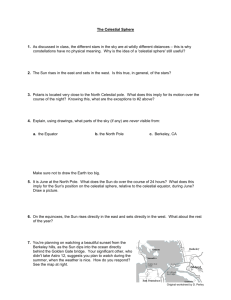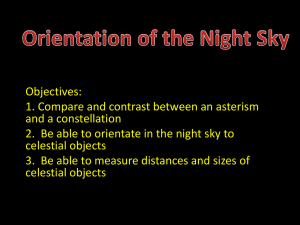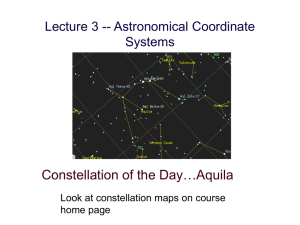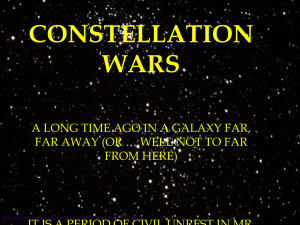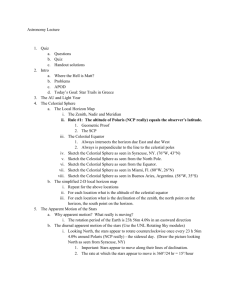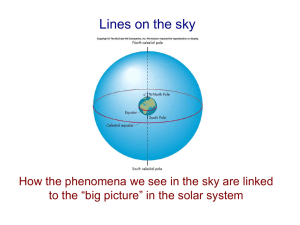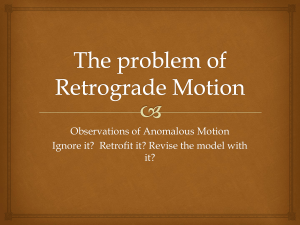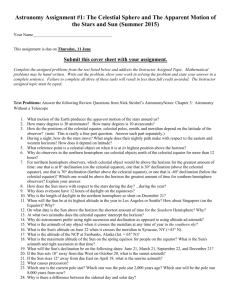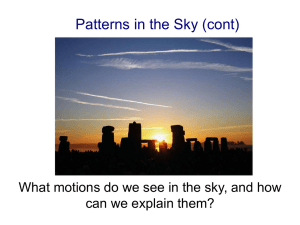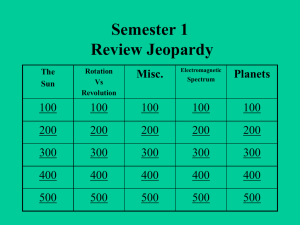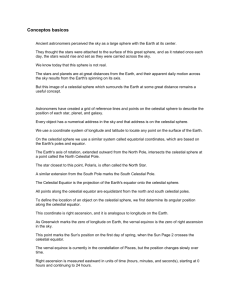Document
advertisement
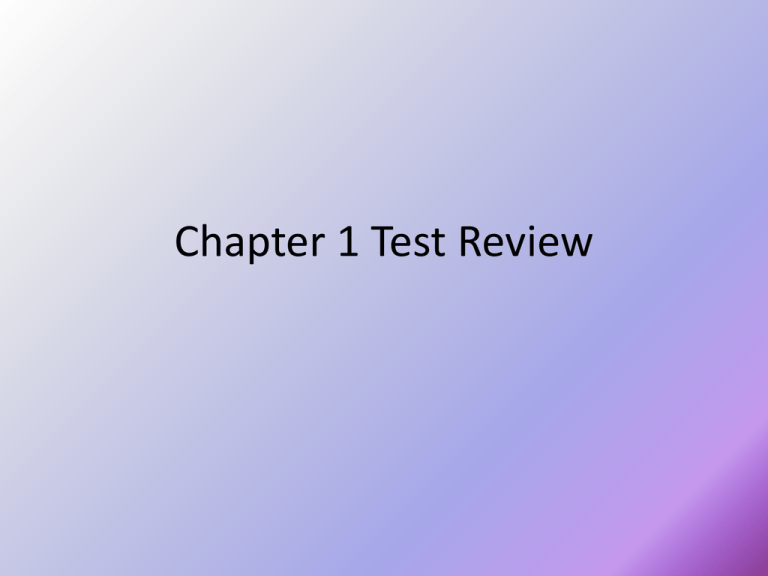
Chapter 1 Test Review 1 According to the heliocentric model, the reason the planets always appear to be near the ecliptic is that a) the ecliptic is only 23.5 degrees from the celestial equator. b) the planets revolve around the Sun in nearly the same plane. c) compared to the stars, the planets are near the Sun. d) the planets come much nearer to us than does the Sun. 2 In the northern hemisphere, the stars rise in the East, set in the West and revolve counter-clockwise around the North celestial pole. In the southern hemisphere the stars rise in the a) East, set in the West and revolve anti-clockwise around the South celestial pole. b) East, set in the West and revolve clockwise around the South celestial pole. c) West, set in the East and revolve clockwise around the South celestial pole. d) West, set in the East and revolve anti-clockwise around the South celestial pole. 3 To see the greatest number of stars possible throughout the period of one year, a person should be located at latitude a) 90 degrees. b) 45 degrees. c) 0 degrees. d) anywhere, since latitude makes no difference. 4 The "equatorial system" of coordinates a) uses the celestial equator as a fundamental reference circle. b) uses the vernal equinox as a fundamental reference point. c) is "attached" to the celestial sphere. d) uses two angles to define a direction in the sky. e) All of the other answers are correct. 5 The physical basis for the equatorial system of coordinates is a) gravity. b) the rotation of the Earth on its axis. c) the revolution of the Earth about the Sun. d) revolution of the Sun about the center of the galaxy. 6 The celestial equator is a) the path of the Sun compared to the stars. b) the path of the Moon compared to the stars. c) always directly overhead at the Earth's equator. d) the average path of planets on a star chart. e) always along the horizon for people on Earth's equator. 7 The ecliptic can be described as the a) projection of the Earth's equator onto the celestial sphere. b) path of a solar eclipse across the Earth. c) Earth's orbital plane projected onto the celestial sphere. d) apparent path of the Moon on the celestial sphere. e) apparent path of the Sun on the celestial sphere. (NOTE: More than one answer possible). 8 Precession is the a) accuracy with which numbers are given in astronomy. b) slow motion of the Earth's rotation axis on the celestial sphere. c) apparent backward motion of planets on the celestial sphere. e) daily eastward motion of the Sun around the celestial sphere. 9 If the star Aldebaran rises tonight at 2:00 a.m., when do you expect it to rise next month? a) 11:00 pm. b) midnight. c) 1:00 am. d) 2:00 am. e) 3:00 am. 10 Ecuador is Spanish for equator. It's September 21 and you're in the capitol, Quito. At noon, how many degrees above the horizon is the Sun? a) 0 b) 30 c) 45 d) 60 e) 90 11 An object transits (crosses your meridian). For that night, the object has achieved its highest a) declination. b) altitude. c) azimuth. d) airmass. 12 The zenith distance of Polaris, the "North Star" a) is always 90 degrees. b) is always 23.5 degrees c) is always 0 degrees. d) varies with your latitude. 13 You're stranded on a desert island. You locate the pole star Polaris. It is 17 degrees above the northern horizon. What is your latitude? a) 73 degrees south. b) 17 degrees north. c) 73 degrees north. d) 17 degrees south. 14 What causes winter to be cooler than summer? a) The Earth is closer to the Sun in summer than in winter. b) The daylight period is longer in summer. c) The Sun gets higher in the sky in summer. d) both B and C. e) all of the above. 15 What is the declination of the Sun on the first day of spring? a) 0 degrees. b) 45 degrees. c) 75 degrees. d) The Sun has no declination because it isn't a fixed star. 16 Northerners have cold days in January because a) the Earth is farthest from the Sun in January. b) the orbital velocity of the Earth is largest in January. c) the Sun is lower in the sky in January. d) El Nino is always strong in January. 17 Imagine a planet whose rotation axis is perpendicular to its orbital plane. How would you describe its seasons? a) shorter than those on Earth. b) longer than those on Earth. c) constant. d) the same as those on Earth. 18 If the Earth were in an orbit farther from the Sun than it is now, a) the day would be longer. b) the day would be shorter. c) the year would be longer. d) the year would be shorter. e) Two of the above are correct. 19 The sidereal day (a full rotation of the Earth measured relative to distant stars) is 4 minutes SHORTER than a solar day. If the Earth's spin were in the opposite direction then a sidereal day would a) not change. b) change, but remain shorter than a solar day. c) be longer than a solar day. d) be the same as a solar day. 20 If the parallax of a star is measured to be 0.1 seconds of arc, its distance is a) 10 astronomical units. b) 10 parsecs. c) 1 parsec. d) 0.1 parsec. e) 0.1 astronomical units. 21 Suppose you measure the parallax of each star in the constellation Taurus (or any other constellation you might choose). Which of the following is the most likely? a) The stars all have the same parallax since we see them together in the same constellation. b) The stars all have nearly the same parallax since they are moving together through space. c) None of them has a measurable parallax since they are mostly within our own Solar System. d) They may have significantly different parallaxes. e) We cannot measure their parallaxes since they are all moving toward our Sun. 22 Which statement about declination is FALSE? a) Polaris is almost at +90 degrees. b) Stars passing your zenith have a declination c) It is measured eastward in units of time. d) equal to your local latitude. e) Its origin is the celestial equator. f) It is much like latitude on the earth's globe.
